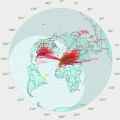jks
About
- Username
- jks
- Joined
- Visits
- 36,265
- Last Active
- Roles
- Member, Administrator, Moderator
- Points
- 641
Reactions
-
rx.kiwisdr.com now has a search field
For what it's worth, rx.kiwisdr.com (aka kiwisdr.com/public) now has a search field where you can search/filter entries from the list.
Same thing as sdr.hu has (and the last reason I was using sdr.hu). Matches are case-insensitive. Clear the search field to restore all entries.
Good for things like searching for Kiwi's on a particular release ("v1.389") or with a particular feature ("drm", "20 kHz", "gps") or location. -
v1.387, 388, 389
From the CHANGE_LOG file:v1.388 April 11, 2020 Desktop UI improvements: Added "tuning lock" to right-click popup menu. When active a single-click in waterfall or DX label area will briefly show a "tuning locked" overlay. Should perhaps be extended to include clicks in tuning scale. Does not effect other methods of tuning, e.g. entry in frequency box, click on +/- step buttons. Mobile UI improvements: Double-tap/touch brings up popup menu (same menu as right-click on desktop). Has tuning lock function same as desktop. Two finger pinch-in/out gesture will zoom the waterfall in/out. Tested on iOS & Android. -
v1.387, 388, 389
-
v1.387, 388, 389
From the CHANGE_LOG file:v1.388 April 11, 2020 Desktop UI improvements: Added "tuning lock" to right-click popup menu. When active a single-click in waterfall or DX label area will briefly show a "tuning locked" overlay. Should perhaps be extended to include clicks in tuning scale. Does not effect other methods of tuning, e.g. entry in frequency box, click on +/- step buttons. Mobile UI improvements: Double-tap/touch brings up popup menu (same menu as right-click on desktop). Has tuning lock function same as desktop. Two finger pinch-in/out gesture will zoom the waterfall in/out. Tested on iOS & Android. -
Request for simple feature: tuning lock [fixed in v1.388]
-
v1.387, 388, 389
From the CHANGE_LOG file:v1.388 April 11, 2020 Desktop UI improvements: Added "tuning lock" to right-click popup menu. When active a single-click in waterfall or DX label area will briefly show a "tuning locked" overlay. Should perhaps be extended to include clicks in tuning scale. Does not effect other methods of tuning, e.g. entry in frequency box, click on +/- step buttons. Mobile UI improvements: Double-tap/touch brings up popup menu (same menu as right-click on desktop). Has tuning lock function same as desktop. Two finger pinch-in/out gesture will zoom the waterfall in/out. Tested on iOS & Android. -
v1.387, 388, 389
From the CHANGE_LOG file:v1.387 April 10, 2020 Admin page control tab: By special request, added ability to limit number of simultaneous non-Kiwi API connections (e.g. kiwirecorder). This works in the same way (and overrides) the TDoA extension setting that limits the number of simultaneous TDoA connections. DX label edit: Passband frequencies can be entered using "k" and "M" suffixes for kHz and MHz. I.e. "2100" and "2.1k" are equivalent, as are "1200000", "1200k" and "1.2M". However subsequent display of the passband field is always in Hz. So after entering "-2.1k, 1.2M" on the next edit the field will display "-2100, 1200000" (Hz). -
v1.387, 388, 389
From the CHANGE_LOG file:v1.387 April 10, 2020 Admin page control tab: By special request, added ability to limit number of simultaneous non-Kiwi API connections (e.g. kiwirecorder). This works in the same way (and overrides) the TDoA extension setting that limits the number of simultaneous TDoA connections. DX label edit: Passband frequencies can be entered using "k" and "M" suffixes for kHz and MHz. I.e. "2100" and "2.1k" are equivalent, as are "1200000", "1200k" and "1.2M". However subsequent display of the passband field is always in Hz. So after entering "-2.1k, 1.2M" on the next edit the field will display "-2100, 1200000" (Hz). -
v1.387, 388, 389
From the CHANGE_LOG file:v1.387 April 10, 2020 Admin page control tab: By special request, added ability to limit number of simultaneous non-Kiwi API connections (e.g. kiwirecorder). This works in the same way (and overrides) the TDoA extension setting that limits the number of simultaneous TDoA connections. DX label edit: Passband frequencies can be entered using "k" and "M" suffixes for kHz and MHz. I.e. "2100" and "2.1k" are equivalent, as are "1200000", "1200k" and "1.2M". However subsequent display of the passband field is always in Hz. So after entering "-2.1k, 1.2M" on the next edit the field will display "-2100, 1200000" (Hz). -
Large masked band segments
Paul, VK3KHZ, from PK's Loop Antennas, brought to my attention the http://plonsk.proxy.kiwisdr.com:8073 Kiwi that has these very wide masked band segments (AKA notched, blacklisted).
How was this done? It turns out it's a feature/bug of the existing masked frequency option available with dx labels. Normally when you setup a dx label and set the "type" menu item to "masked" the width of the masked frequency area is the passband of the label's mode (AM, CW, ...) But the dx label panel also contains a "passband" field where you can specify a custom passband which overrides the default.
Well, it turns out you can specify a ridiculously wide passband too. The audio code will clamp an overly wide passband to 12 or 20.25 kHz depending on the Kiwi FPGA configuration, but the masked frequency code will happily take your crazy passband width and block a huge segment of spectrum. So creating a dx label at 1120 kHz with the passband field set to "1180k" would mask the entire NA 530 - 1710 kHz AM BCB (530 = 1120 - 1180/2, 1710 = 1120 + 1180/2). The passband field also accepts a "lo, high" specification (e.g. "300, 2700" for a USB passband). So you could specify a large asymmetrical masked segment as well (label at 6 MHz, passband "-10M, 20M" to get a masked segment from 5 - 8 Mhz). Note the usual 'k' and 'M' suffixes can be used for kHz and MHz respectively.
Rather than specify the middle of the masked range and the width you can also specify the starting frequency and width which might be more convenient. Say you want to mask 26 - 27 MHz. Create a masked label at 26 MHz and set the passband field to "0,1M".
Pretty cool. Thanks Paul!







